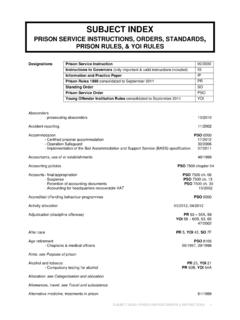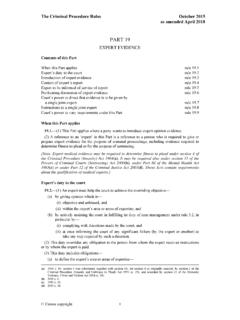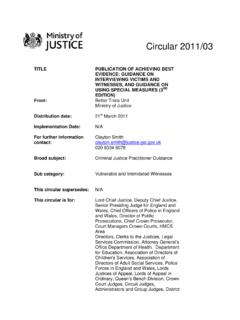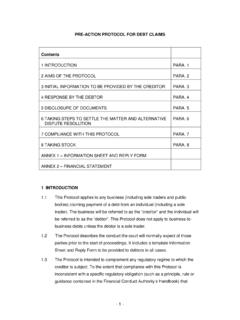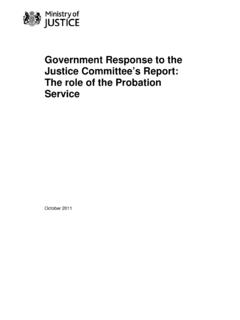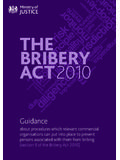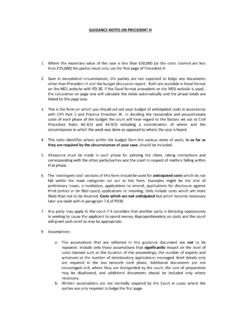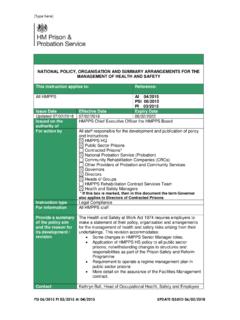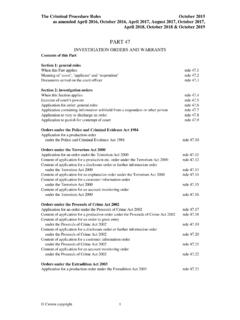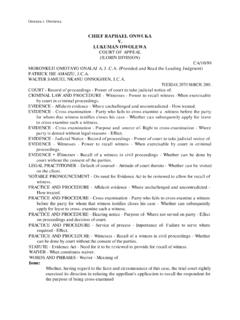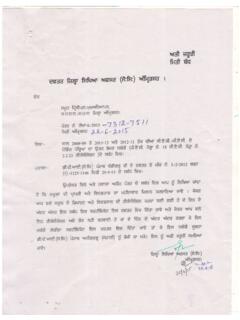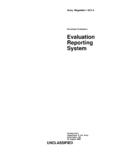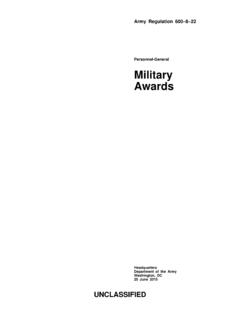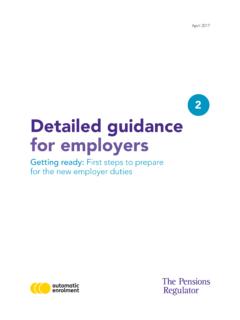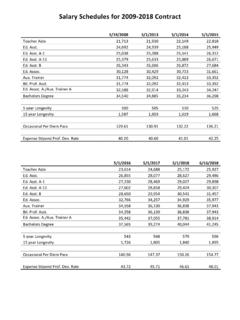Transcription of Criminal Practice Directions VII: Sentencing - …
1 Criminal Practice Directions Table of Content 1 CPD Division CPD ref Title of CPD, if applicable CPD I General matters A CPD I General matters 1A CPD I General matters 3A Case management CPD I General matters 3B Pagination and indexing of served evid ence CPD I General matters 3C Abuse of process stay applications CPD I General matters 3D Vulnerable people in the Courts CPD I General matters 3E Ground rules hearings to plan the questioning of a efendant vulnerable witness or dCPD I General matters 3F Intermediaries CPD I General matters 3G Vulnerable defendants CPD I General matters 3H Wales and the Welsh Language: Devolution issues CPD I General matters 3J Wales and the Welsh Language: Applications for evidence to be given in Welsh CPD I General matters 3K Wales and the Welsh Language: Use of the Welsh Language in Courts in Wales CPD I General matters 5A Forms CPD I General matters 5B Access to information held by the Court CPD II Preliminary proceedings 6A Investigation orders and warrants CPD II Preliminary proceedings 9A Allocation (mode of trial) CPD II Preliminary proceedings 10A Defendant s record CPD II Preliminary proceedings 14A Settling the indictment CPD II Preliminary proceedings 14B Voluntary bills of indictment CPD II Preliminary proceedings 16A Unofficial sound recording of proceedings CPD II Preliminary proceedings 16B Restrictions on reporting proceedings CPS III Custody and bail 19A Bail before sending for trial CPD III Custody and bail 19B Bail.
2 Failure to surrender and trials in absence CPD III Custody and bail 19C Penalties for failure to surrender CPD III Custody and bail 19D Relationship between the Bail Act offence and further remands on bail or in custody CPD III Custody and bail 19E Trials in absence CPD III Custody and bail 19F Forfeiture of monies lodged as security or pledged by a surety/estreatment of recognizances CPD III Custody and bail 19G Bail during trial CPD III Custody and bail 19H Crown Court judge s certification of fitness to appeal and applications to the Crown Court for 2bail pending appeal CPD IV Disclosure 22A Disclosure of unused material CPD V Evidence 27A Evidenc e by written statement CPD V Evidence 27B Video recorded evidence in chief CPD V Evidence 27C Evidence of audio and video recorded interveiws CPD V Evidence 28A Wards of Court and children subject to current Family proceedings CPD V Evidence 29A Measures to assist a witness or defendant to give evidence CPD V Evidence 29B Witnesses giving evidence by live link CPD V Evidence 29C Visually recorded interviews: memory refreshing time from the jury and watching at a different CPD V Evidence 29D Witness anonymity orders CPD V Evidence 35A Spent convictions CPD VI Trial 37A Role of the justices clerk/legal adviser CPD VI Trial 39A Juries: introduction CPD VI Trial 39B Juries: preliminary matters arising before jury service commences CPD VI Trial 39C Juries: eligibility CPD VI Trial 39D Juries: precautionary measures before swearing CPD VI Trial 39E Juries: swearing in jurors CPD VI Trial 39F Juries: ensuring an effective jury panel CPD VI Trial 39G Juries: preliminary instructions to jurors CPD VI Trial 39H Juries: discharge of a juror for personal reasons CPD VI Trial 39J Juries: views CPD VI Trial 39K Juries: Directions to jury before retirement CPD VI Trial 39L Juries.
3 Jury access to exhibits and evidence in retirement CPD VI Trial 39M Jury Irregularities CPD VI Trial 39N Open justice CPD VI Trial 39P Defendant s right to give or not to give evidence CPD VI Trial 39Q Majority verdicts CPD VII Sentencing A Pleas of guilty in the Crown Court CPD VII Sentencing B Determining the factual basis of sentence CPD VII Sentencing C Indications of sentence: R v Goodyear CPD VII Sentencing D Facts to be stated on pleas of guilty CPD VII Sentencing E Concurrent and consecutive sentences CPD VII Sentencing F Victim Personal Statements CPD VII Sentencing G Families bereaved by homicide onduct and other Criminal cCPD VII Sentencing H Community Impact Statements CPD VII Sentencing I CPD VII Sentencing J Binding over orders and conditional discharges CPD VII Sentencing K Committal for sentence CPD VII Sentencing L Imposition of life sentences CPD VII Sentencing M Mandatory life sentences CPD VII Sentencing N Transitional arrangements for sentences where the offence was committed before 18 December 2003 CPD VII Sentencing P Procedure for announcing the minimum term in open court CPD IX Con court tempt of 62A Con tempt in the face of the magistrates court CPD X Appeal 63A Appeals to the Crown Court CPD X Appeal 68A Appeals against conviction and sentence the
4 Provision of notice to the prosecution CPD X Appeal 68B Listing of appeals against conviction and sent Criminal Division (CACence D) in the Court of AppealCPD X Appeal 68C Appeal notices containing grounds of appeal CPD X Appeal 68D Respondents notices CPD X Appeal 68E Loss of time CPD X Appeal 68F Skeleton arguments CPD X Appeal 68G Criminal Appeal Office summaries CPD X Appeal 75A References to the European Court of Justice CPD XI Costs CPD XII General application A Court dress CPD XII General application B Modes of address and titles of judges and magistrates CPD XII General application C Availability of judgments given in the Court of Appeal and the High Court CPD XII General application D Citation of authority and provision of copiejudgments to the Court s of CPD XII General application E Preparation of judgments: neutral citation CPD XII General application F Citation of Hansard VII Sentencing C PD VInteI Se ncing A: PLEAS OF GUILTY IN THE CROWN COURT Prosecutors and Prosecution Advocates should be familiar with and follow the Attorney General s Guidelines on the Acceptance of Pleas and the Prosecutor s Role in the Sentencing Exercise.
5 CPD VII Sentencing B: DETERMINING THE FACTUAL BASIS OF SENTENCE Where a guilty plea is offered to less than the whole indictment and the prosecution is minded to accept pleas tendered to some counts or to lesser alternative counts. In some cases, defendants wishing to plead guilty will simply plead guilty to all charges on the basis of the facts as alleged and opened by the prosecution, with no dispute as to the factual basis or the extent of offending. Alternatively a defendant may plead guilty to some of the charges brought; in such a case, the judge will consider whether that plea represents a proper plea on the basis of the facts set out by the papers. 3 Where the prosecution advocate is considering whether to accept a plea to a lesser charge, the advocate may invite the judge to approve the proposed course of action. In such circumstances, the advocate must abide by the decision of the judge. If the prosecution advocate does not invite the judge to approve the acceptance by the prosecution of a lesser charge, it is open to the judge to express his or her dissent with the course proposed and invite the advocate to reconsider the matter with those instructing him or her.
6 In any proceedings where the judge is of the opinion that the course proposed by the advocaadjourn to a te may lead to serious injustice, the proceedings may be ed llow the following procedure to be followed: (a) as a preliminary step, the prosecution advocate must discuss the judge s observations with the Chief Crown Prosecutor or the senior prosecutor of the relevant prosecuting authority as appropriate, in an attempt to resolve the issue; (b) where the issue remains unresolved, the Director of Public Prosecutions or the Director of the relevant prosecuting authorityshould be consulted; (c) in extreme circumstances the judge may decline to proceed with the case until the prosecuting authority has consulted with the Attorney General, as may be appropriate. Prior to entering a plea of guilty, a defendant may seek an indication of sentence under the procedure set out in R v Goodyear [2005] EWCA Crim 888, [2005] 1 2532, [2005] 2 Cr.
7 App. R. 20; see below. ereWh a guilty plea is offered on a limited basis A defendant may put forward a plea of guilty without accepting all of the facts as alleged by the prosecution. The basis of plea offered may seek to limit the facts or the extent of the offending for which the defendant is to be sentenced. Depending on the view taken by the prosecution, and the content of the offered basis, t ase he c will fall into one of the following categories: a) a plea of guilty upon a basis of plea agreed by the prosecution and (defence; b) a plea of guilty on a basis signed by the defendant but in respect ; (of which there is no or only partial agreement by the prosecution (c) a plea of guilty on a basis that contains within it matters that are purely mitigation and which do not amount to a contradiction of the prosecution case; or (d) in cases involving serious or complex fraud, a plea of guilty upon a basis of plea agreed by the prosecution and defence accompanied by joint submissions as to sentence.
8 4 (a) A plea of guilty upon a basis of plea agreed by the prosecution and defence The prosecution may reach an agreement with the defendant as to the factual basis on which the defendant will plead guilty, often known as an agreed basis of plea . It is always subject to the approval of the court, which will consider whether it adequately and appropriately reflects the evidence as disclosed on the papers, whether it is fair and whether it is in the interests of justice. R v Underwood [2004] EWCA Crim 2256, [2005] 1 Cr. App. R. 13, [2005] 1 Cr. App. R. (S.) 90 outlines the principles to be applied where the defendant admits that he or she is guilty, but disputes the basis of offending alleged by the prosecution: (a) The prosecution may accept and agree the defendant s account of the disputed facts or reject it in its entirety, or in part. If the prosecution accepts the defendant s basis of plea, it must ensure that the basis of plea is factually accurate and enables the Sentencing judge to impose a sentence appropriate to reflect thejustice of the case; (b) In resolving any disputed factual matters, the prosecution must consider its primary duty to the court and must not agree with or acquiesce in an agreement which contains material factual disputes; (c) If the prosecution does accept the defendant s basis of plea, it must be reduced to writing, be signed by advocates for both sides, and made available to the judge prior to the prosecution s opening; (d) An agreed basis of plea that has been reached between the parties should not contain matters which are in dispute and any aspects upon which there is not agreement should be clearly identified.
9 (e) On occasion, the prosecution may lack the evidence positively to dispute the defendant s account, for example, where the defendant asserts a matter outside the knowledge of the prosecution. Simply because the prosecution does not have evidence to contradict the defendant s assertions does not mean those assertions should be agreed. In such a case, the prosecution should test the defendant s evidence and submissions by requesting a Newton hearing (R v Newton (1982) 77 Cr. App. R. out 13, (1982) 4 Cr. App. R. (S.) 388), following the procedure setbelow. (f) If it is not possible for the parties to resolve a factual dispute when attempting to reach a plea agreement under this part, it is the responsibility of the prosecution to consider whether the matter should proceed to trial, or to invite the court to hold a Newton hearing as necessary. R v Underwood emphasises that, whether or not pleas have been agreed , the judge is not bound by any such agreement and is entitled of his or her own 5motion to insist that any evidence relevant to the facts in dispute (or upon which the judge requires further evidence for whatever reason) should be called.
10 Any view formed by the prosecution on a proposed basis of plea is lea. deemed to be conditional on the judge s acceptance of the basis of p A judge is not entitled to reject a defendant s basis of plea absent a Newton hearing unless it is determined by the court that the basis is manifestly false and as such does not merit examination by way of the calling of evidence or alternatively the defendant declines the opportunity to engage in the process of the Newton hearing whether by giving evidence on his own behalf or otherwise. (b) a plea of guilty on a basis signed by the defendant but in respect of which there is no or only partial agreement by the prosecution Where the defendant pleads guilty, but disputes the basis of offending alleged by the ecu following procedure shopros tion and agreement as to that has not been reached, theuld be followed: (a) The defendant s basis of plea must be set out in writing, identifying what is in dispute and must be signed by the defendant; (b) The prosecution must respond in writing setting out their alternative contentions and indicating whether or not they submit that a Newton hearing is necessary; t (c) The court may invite the parties to make representations abouwhether the dispute is material to sentence.
